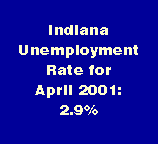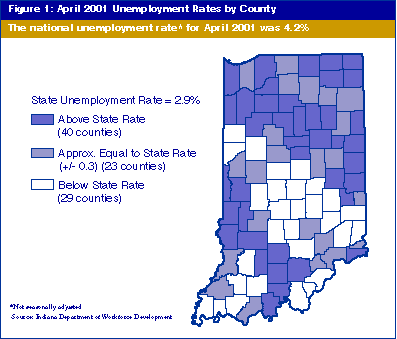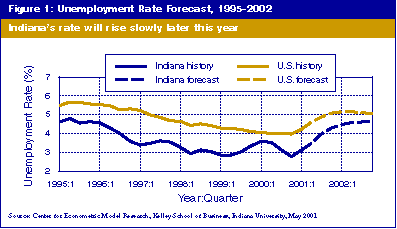Indiana's Unemployment Rate Lower than Surrounding States
The unemployment rate in Indiana dipped in April, to a non-seasonally adjusted 2.9%. The average rate in the state for the first three months of 2001 was about 3.5%. Nationally, the non-seasonally adjusted unemployment rate was 4.2% in April, also a decline from first quarter levels.
This improvement in the unemployment rate occurred even though Indiana's labor force expanded. The total civilian labor force rose by nearly 32,000 in April over the first three months' average.
Strong gains in employment in the Indianapolis metropolitan area led the state. Unemployment in Indianapolis fell to 2.1% in April. The Gary metro area, made up of Lake and Porter counties, had 3,000 more of its residents employed in April than in March. The April unemployment rate in Gary, Indiana's second largest metro area, dropped to 3.6% from 4.2% in the prior month.
In every Indiana metro area, in fact, employment and the unemployment rate both improved in April. Even Kokomo, where manufacturing cutbacks have made headlines, saw its unemployment rate shrink to 4.3% in April from 5.9% in March.
Indiana's 2.9% unemployment rate was the best among its neighboring states in April. Ohio's rate improved to 3.6%, while Kentucky held steady at 4.1%. Unemployment rates rose to 4.4% in Michigan and 5.1% in Illinois.
Highest Unemployment Rates, April 2001:
| Counties | Metro Areas |
| Orange: 7.2% | Kokomo: 4.3% |
| Greene: 5.4% | Terre Haute: 4.1% |
Lowest Unemployment Rates, April 2001:
| Counties | Metro Areas | |
|
|
 |
Change in the Number of People Employed,
April 2001 Compared to April 2002:
| Largest County Increases | Largest County Declines |
|
|
Click on map to see zoomable PDF version with data.

IU Economic Forecast Sees Flat Year
We should expect little economic growth in Indiana for the rest of this year, according to the latest economic forecast from Indiana University.
The Center for Econometric Model Research in Bloomington produces econometric forecasts of the Indiana and U.S. economies. Whereas real personal income in Indiana grew 3.2% in 2000, the Center's model predicts less than a 1% increase in 2001. Although Indiana's income did decline slightly in the first quarter of this year (down 1.25% at an annual rate), some strengthening later in 2001 is expected to produce a small positive growth rate for the year.
The Center's forecast shows unemployment climbing, too (see Figure 1). After sinking to record-low levels during 2000, Indiana's unemployment rate should follow the U.S. rate up later this year. By the end of 2001, expect unemployment in Indiana to top 4%, up from around 3% in the early part of this year. That's still not a high rate of unemployment by historical standards. Indiana's rate was above 4% as recently as 1995 and 1996, in the heart of the last decade's economic boom. On average, then, businesses in Indiana should see about the same level of sales as last year. Lower sales at manufacturing firms are likely to be offset by higher revenues in the health and business services sectors and in financial sectors.
The U.S. economy will not go into recession this year, according to the Center's forecast. Gross domestic product should rise about 1.8% in real terms. While small by comparison to the 5% jump in 2000, this positive growth rate for 2001 means that lower interest rates, a strengthening stock market and renewed consumer confidence should begin to move the national economy forward at a brisker pace later this year. Already we are seeing encouraging national sales figures for vehicles and housing.

